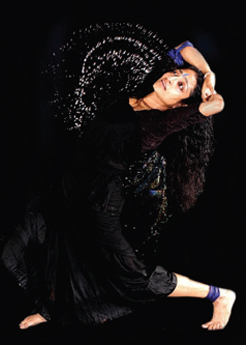Ananya’s Army on the Move: Duurbaar
Camille LeFevre saw this weekend's performances of "Duurbaar: Journeys Into Horizon," and marveled at the troupe's athleticism, strength, and singularity. The show runs through Sept. 17 at the Southern Theater.

Dance-critic caveats: I know little about the Indian classical-dance
form Odissi or the Orrisian martial-art practice Chhau. I am a woman,
but not of color. And while I understand that process is a critical
part of creating any work of art, audiences are not privy to process,
so what appears on stage is what I critique.
That said, Ananya Dance Theatre’s new dance work for 15
women (and two girls) of color, Duurbaar: Journeys Into Horizon—-an
outgrowth, according to the program, of a year-long process involving
storytelling, “performance workshops on vigilance,” anti-sexism and –
racism workshops, and ongoing dialogue—-clearly has a mission. That
mission is womanpower, particularly women-of-color power, of the
relentlessly intense, ferociously unswerving kind.
ADT is arguably the best-drilled band of dancers, with
the most sustained focus, of any company in town. The movement
vocabulary, created by artistic director Ananya Chatterjea, is a
rigorous blend of yoga, Odissi and Chhau. That means (and it’s not
always clear where the yoga leaves off, and the other two begin) that
the women spend a lot of time in lunged warrior poses, or with their
hips and feet wide open with knees bent.
They travel percussively across the stage with their feet slapping
loudly, rhythmically and warningly (like a beaver tale on the water’s
surface). Their arms sharply whip around them like swords or scythes.
Some have a look of madness as they stare, eyes wide and unblinking,
at an indeterminate point in space. They punctuate their movements
with sharply vocalized breaths, or spoken syllables that guide the
entire group as they charge en masse (and in unison) through space or
crawl like inchworms across the floor.
They’re a force. They’re an army, Ananya’s army. They are indeed
beautiful in their statuesque poses, performed with flawless
technique. Their unwavering certainty is inspiring. Even when a
dancer “drags” Chatterjea across the floor with foot slaps, or
“beats” Chatterjea down with faux kicks and hammering fists,
Chatterjea displays indomitable fortitude. Yes, these women are
“duurbaar, ” the Bengali word for “unstoppable.”
And there certainly were moments during the 90-minute performance
that I wished they would stop already, or at least have trimmed some
of the repetition. A suspended, ritualistic sense of time seemingly
qualifies, and girds, the repetitiveness, as well as the almost
unvarying tone. While there are sections in which the pace and
activity slow, the overall tone is one of articulate ferocity.
Underscoring the monotony is taped sound consisting of a woman’s echoing chanted syllables, or an instrumental soundscape.
Duurbaar also conveys little sense of form, although the piece
could be lightly separated into three ritualized parts. In all,
vessels are the dominant symbol. In the beginning, Chatterjea carries
a small empty brass vessel in each hand, which she loses and regains.
There’s a scene, about midway through the piece, in which women
carrying larger empty vessels on their shoulders slowly walk in a
line diagonally across the stage, as groups of dancers perform around
them.
Sometime after, the women become the archetypal vessels. They inch en
masse across the floor—their knees bent and feet touching to form
triangles behind them—stand up, open their legs again, draw their
hands across their pubic areas, and Chatterjea is “birthed” between
their legs into the arms of her 10-year-old daughter, Srija
Chatterjea Sen (a charming little acrobat, and seemingly Chatterjea’s
younger reflection in their duets in this work).
Duurbaar concludes with a ceremonial cleansing. The women reappear
on stage with their vessels full of water, which they pour out onto
the floor. They skim across and splash through the water, as
Chatterjea stands beneath a shower, her movements now sensual. At
last, some faces are relaxed, even slyly smiling. The ritual
purification is achieved. Ananya’s army is ready for its next
assignment. And we’ll be paying attention.